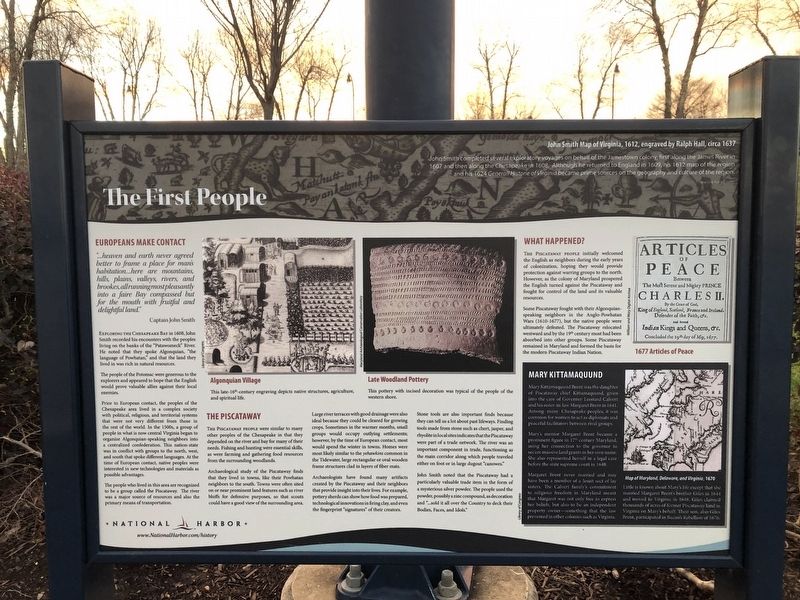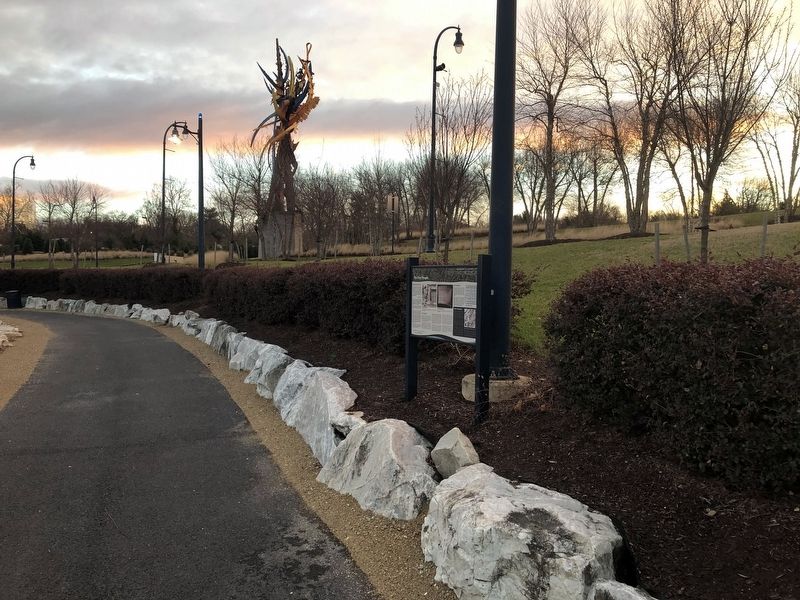Forest Heights in Prince George's County, Maryland — The American Northeast (Mid-Atlantic)
The First People
"...heaven and earth never agreed better to frame a place for man's habitation...here are mountains, hills, plains, valleys, rivers, and brookes, all running most pleasantly into a faire Bay compassed but for the mouth with fruitful and delightful land."
Captain John Smith
Exploring the Chesapeake Bay in 1608, John Smith recorded his encounters with the peoples living on the banks of the "Patawmeck" River. He noted that they spoke Algonquian, "the language of Powhatan," and that the land they lived in was rich in natural resources.
The people of the Potomac were generous to the explorers and appeared to hope that the English would prove valuable allies against their local enemies.
Prior to European contact, the peoples of the Chesapeake area lived in a complex society with political, religious, and territorial systems that were not very different from those in the rest of the world. In the 1500s, a group of people in what is now central Virginia began to organize Algonquian-speaking neighbors into a centralized confederation. This nation-state was in conflict with groups to the north, west, and south that spoke different languages. At the time of European contact, native peoples were interested in new technologies and materials as possible advantages.
The people who lived in this area are recognized to be a group called the Piscataway. The river was a major source of resources and also the primary means of transportation.
The Piscataway
The Piscataway people were similar to many other peoples of the Chesapeake in that they depended on the river and bay for many of their needs. Fishing and hunting were essential skills, as were farming and gathering food resources from the surrounding woodlands.
Archaeological study of the Piscataway finds that they lived in towns, like their Powhatan neighbors to the south. Towns were often sited on or near prominent land features such as river bluffs for defensive purposes, so that scouts could have a good view of the surrounding area.
Large river terraces with good drainage were also ideal because they could be cleared for growing crops. Sometimes in the warmer months, small groups would occupy outlying settlements; however, by the time of European contact, most would spend the winter in towns. Homes were most likely similar to the yehawkins common in the Tidewater, large rectangular or oval wooden frame structures clad in layers of fiber mats.
Archaeologists have found many artifacts created by the Piscataway and their neighbors that provided insight into their lives. For example, pottery sherds can show how food was
Stone tools are also important finds because they can tell us a lot about past lifeways. Finding tools made from stone such as chert, jasper, and rhyolite in local sites indicates that the Piscataway were part of a trade network. The river was an important component in trade, functioning as the main corridor along which people traveled either on foot or in large dugout "canowes."
John Smith noted that the Piscataway had a particularly valuable trade item in the form of a mysterious silver powder. The people used the powder, possibly a zinc compound, as a decoration and "...sold it all over the Country to deck their Bodies, Faces, and Idols."
What Happened?
The Piscataway people initially welcomed the English as neighbors during the early years of colonization, hoping they would provide protection against warring groups to the north. However, as the colony of Maryland prospered, the English turned against the Piscataway and fought for control of the land and its valuable resources.
Some Piscataway fought with their Algonquian-speaking neighbors in the Anglo-Powhatan Wars (1610-1677), but the native people were ultimately defeated. The Piscataway relocated westward and by the 19th century most had been absorbed into other groups. Some Piscataway remained in Maryland and formed the basis for the modern Piscataway Indian Nation.
Mary Kittamaquund
Mary Kittamaquund Brent was the daughter of Piscataway chief Kittamaquund, given into the care of Governor Leonard Calvert and his sister-in-law Margaret Brent in 1641. Among many Chesapeake peoples, it was common for women to act as diplomats and peaceful facilitators between rival groups.
Mary's mentor Margaret Brent became a prominent figure in 17th century Maryland, using her connection to the governor to secure massive land grants in her own name. She also represented herself in a legal case before the state supreme court in 1648.
Margaret Brent never married and may have been a member of a Jesuit sect of lay sisters. The Calvert family's commitment to religious freedom in Maryland meant that Margaret was not only free to express her beliefs, but also to be an independent property owner–something that the law prevented in other colonies such as Virginia.
Little is known about Mary's life except that she married Margaret Brent's brother Giles in 1644 and moved to Virginia in 1648. Giles claimed thousands of acres of former Piscataway land in Virginia on Mary's behalf. Their son, also Giles Brent, participated in Bacon's Rebellion of 1676.
[Image Captions:]
John Smith Map of Virginia, 1612, engraved by Ralph Hall, circa 1637
John Smith completed several exploratory voyages on behalf of the Jamestown colony, first along the James River in 1607 and then along the Chesapeake in 1608. Although he returned to England in 1609, his 1612 maps of the region and his 1624 Generall Historie of Virginia became prime sources on the geography and culture of the region.
Algonquian Village
This late 18th-century engraving depicts native structures, agriculture, and spiritual life.
Late Woodland Pottery
This pottery with incised decoration was typical of the people of the western shore.
1677 Articles of Peace
Map of Maryland, Delaware, and Virginia, 1670.
Topics. This historical marker is listed in these topic lists: Exploration • Native Americans • Women. A significant historical year for this entry is 1608.
Location. 38° 47.257′ N, 77° 0.869′ W. Marker is in Forest Heights, Maryland, in Prince George's County. Marker can be reached from National Harbor Boulevard south of Capital Beltway (Interstate 95), on the right when traveling south. Touch for map. Marker is at or near this postal address: 7200 Harborview Avenue, Oxon Hill MD 20745, United States of America. Touch for directions.
Other nearby markers. At least 8 other markers are within walking distance of this marker. Africans Becoming Americans (about 400 feet away, measured in a direct line); Franklin D. Roosevelt (about 400 feet away); Dwight D. Eisenhower (about 400 feet away); The Architecture of Oxon Hill Manor (about 600 feet away); After the Addisons (about 700 feet away); Archaeology at Oxon Hill (approx. 0.2 miles away); Skipjacks (approx. 0.2 miles away); Triple Crown (approx. 0.2 miles away). Touch for a list and map of all markers in Forest Heights.
Credits. This page was last revised on March 21, 2019. It was originally submitted on December 22, 2018, by Devry Becker Jones of Washington, District of Columbia. This page has been viewed 192 times since then and 9 times this year. Photos: 1, 2. submitted on December 22, 2018, by Devry Becker Jones of Washington, District of Columbia. • Andrew Ruppenstein was the editor who published this page.

